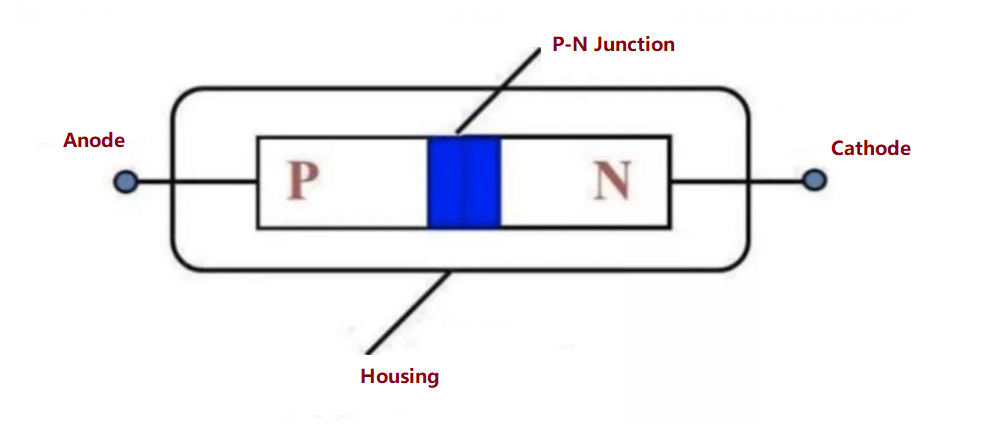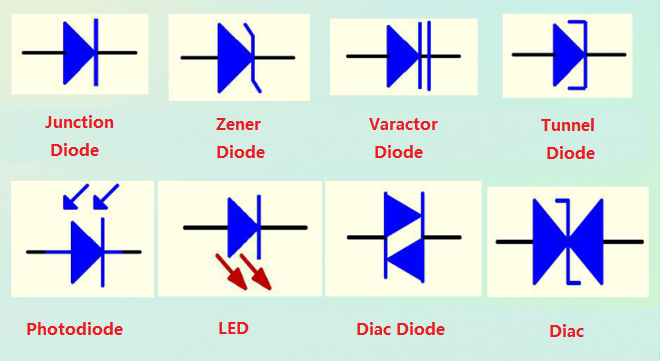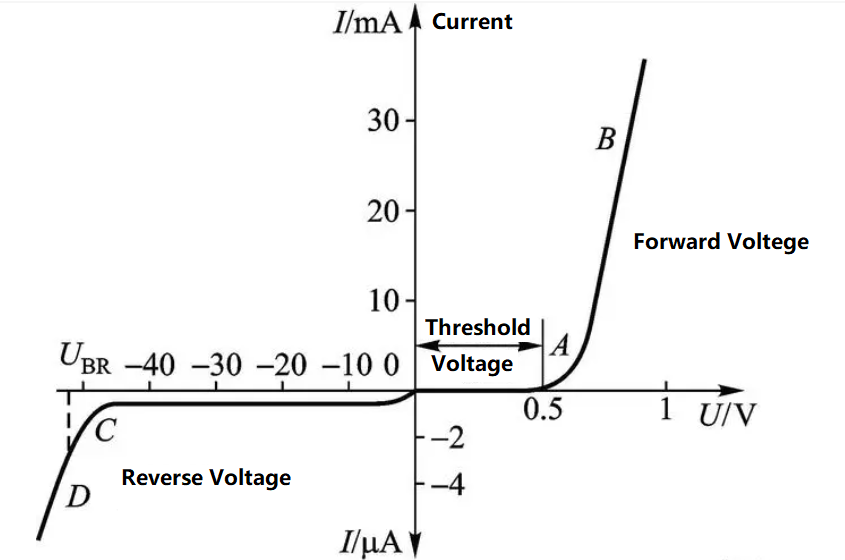What is Diode - Definition, Diode Symbol, Functions

What is Diode and Why is it Used?
A diode is a semiconductor device that allows current to flow in one direction only. This property is called unidirectional conductivity. Diodes are made from materials like silicon or germanium. The basic structure of a diode involves a junction of p-type and n-type semiconductor materials.
This junction creates a depletion region where no charge carriers exist, allowing the diode to control the flow of current. Diodes have two terminals: an anode (positive side) and a cathode (negative side). When the anode is positive relative to the cathode, the diode conducts current; this is known as forward bias. When the anode is negative relative to the cathode, the diode blocks current; this is called reverse bias.

The unique property of diodes to conduct electricity in one direction makes them essential in electronic circuits. They are used to protect circuits, rectify AC to DC, and control the direction of current. This ability to control the direction of current flow is crucial in various applications, such as signal modulation, power conversion, and circuit protection. Diodes are also used in various sensing applications, where they can detect light, temperature, and other physical phenomena.
Types of Diodes
There are several types of diodes, each designed for specific functions and unique symbols:Rectifier Diode
One of most common types of diodes, often used in power supplies to convert AC to DC. These diodes are designed to handle high currents and voltages. They are commonly found in power adapters and converters.
Avalanche Diode
Designed to break down and conduct at a specific reverse voltage. Avalanche diodes are used in high-voltage applications and protection circuits. They can handle large voltage spikes without damage, making them ideal for surge protection.
Zener Diode
Maintains a constant voltage across its terminals. Zener diodes are used in voltage regulation and protection circuits. They allow current to flow in the reverse direction when a specific breakdown voltage is reached, ensuring stable voltage supply.
Light Emitting Diode (LED)
This kind of diode can emit light when current flows through it. LEDs are widely used in display technology, indicators, and lighting. They are energy-efficient and come in various colors based on the semiconductor material used.
Laser Diode
It is a different type of diode as it produces coherent light. It can emit coherent light when current passes through it. Laser diodes are used in applications requiring focused light, such as laser pointers, optical communication, and medical devices. They are efficient and can produce a narrow, intense beam of light.
Schottky Diode
Known for its low forward voltage drop. Schottky diodes are used in high-speed switching applications and power rectification. They have fast recovery times and are often used in power supplies and RF applications.
Photodiode
Converts light into electrical current. Photodiodes are used in sensors, solar cells, and optical communication systems. They are sensitive to light and can detect a wide range of wavelengths.
P-N Junction Diode
The simplest type of diode, formed by joining p-type and n-type semiconductor materials. P-N junction diodes are used in rectification, switching, and signal modulation. They are fundamental components in many electronic circuits.
Tunnel Diode
Used for high-speed switching. Tunnel diodes operate on the principle of quantum tunneling and are used in microwave and high-frequency applications. They have negative resistance characteristics, which allow them to amplify signals.
Diode Symbols

Why are Diodes Used in Circuit Protection?
Diodes protect circuits by preventing reverse current that can damage components. For instance, a flyback diode across a relay coil prevents voltage spikes when the relay is de-energized. These spikes can otherwise damage the relay or other components in the circuit. Zener diodes are used in voltage regulation to protect sensitive electronics from overvoltage. They ensure that the voltage across sensitive components does not exceed a safe level.In addition to protecting against voltage spikes, diodes can prevent reverse polarity connections. If a power supply is connected backward, a diode can block the incorrect current flow and prevent damage. This is particularly useful in battery-powered devices where incorrect battery installation could cause damage.
Diodes are also used in electrostatic discharge (ESD) protection. ESD can damage sensitive electronic components, and diodes can safely shunt the excess charge to the ground, protecting the circuit. This is critical in environments where static electricity is a concern, such as in semiconductor manufacturing or handling.
What is the Main Function of a Diode?
The primary function of a diode is to allow current to flow in one direction while blocking it in the opposite direction. This property is fundamental in converting AC to DC, known as rectification. Diodes also stabilize voltage, prevent backflow of current, and are used in signal modulation and demodulation.In rectification, diodes convert the alternating current from the mains to direct current required by electronic devices. This conversion is essential for powering devices like laptops, smartphones, and household appliances. Diodes ensure that the current flows in the correct direction, providing a stable DC supply.
Diodes also play a crucial role in voltage regulation. Zener diodes maintain a constant voltage across their terminals, ensuring that sensitive components receive a stable voltage supply. This prevents damage from voltage fluctuations and ensures reliable operation.
In signal processing, diodes are used to modulate and demodulate signals. This is essential in communication systems, where signals need to be transmitted and received accurately. Diodes ensure that signals are processed correctly, allowing for clear and reliable communication. You can see a basic structure of a P-N Diode as above.
Without diodes, many electronic devices would be inefficient or inoperative. Diodes ensure that electronic circuits function correctly and reliably, making them indispensable components in modern electronics.
Characteristics of Diode
Diodes have several key characteristics:
Forward Voltage
Reverse Breakdown Voltage
Reverse current
Capacitance
Forward Voltage
The voltage required for the diode to conduct. For silicon diodes, this is typically around 0.7 volts, while for germanium diodes, it is around 0.3 volts. Schottky diodes have an even lower forward voltage drop, around 0.2 volts.
Reverse Breakdown Voltage
The maximum reverse voltage a diode can withstand without breaking down. Zener diodes are designed to break down at a specific voltage, allowing them to be used in voltage regulation applications.
Reverse current
Reverse current refers to the reverse current flowing through the diode at room temperature (25C) and the highest reverse voltage. The smaller the reverse current, the better the one-way guiding electrical performance of the tube. It is worth noting that the reverse current is closely related to temperature, and the reverse current doubles for every 10C increase in temperature. For example, 2AP1 type germanium diode, if the reverse current is 250μA at 25C, the temperature rises to 35C, the reverse current will rise to 500μA, and so on. At 75C, its reverse current has reached 8mA, not only lost the single-direction conductive characteristics, but also caused the tube to overheat and damage.

Understanding these characteristics is vital for selecting the right diode for a specific application. It ensures that the diode will perform as expected and provide reliable operation in the circuit.
What Happens When a Diode is Bad?
A bad diode can either fail open or short. If open, it stops conducting electricity, causing circuit malfunction. This can lead to power supply failure or the malfunctioning of electronic devices. If short, it allows current to flow both ways, potentially damaging other components. This can cause overheating and failure of other components in the circuit.Common symptoms of a bad diode include:
Power Supply Failure: If a rectifier diode fails, the power supply may not provide the correct DC voltage, causing the device to malfunction.
Malfunctioning Electronic Devices: Devices may behave erratically or stop working altogether if a diode in the circuit fails.
Overheating Components: A shorted diode can cause excessive current to flow, leading to overheating and potential damage to other components.
Where are Diodes Used in Everyday Life?
Diodes are everywhere in daily life and you can see it in very common devices, like:
Convert AC to DC in chargers and adapters. This is essential for powering electronic devices like smartphones, laptops, and household appliances.
LEDs
Used in lighting, displays, and indicators. LEDs are energy-efficient and long-lasting, making them ideal for various applications, from lighting to digital displays.
Solar Panels
Convert sunlight to electricity. Photodiodes in solar panels convert light into electrical energy, providing a renewable energy source.
Communication Devices
Manage signal direction and modulation. Diodes are used in mixers, modulators, and demodulators to process communication signals.
Protective Circuits
Prevent damage from voltage spikes. Diodes protect sensitive components from transient voltage spikes, ensuring reliable operation.
Their presence is crucial in making modern electronic devices efficient and reliable. Diodes play a vital role in various applications, ensuring that electronic devices function correctly and efficiently.
Does a Diode Convert AC to DC?
Yes, diodes are essential in converting AC to DC, a process known as rectification. In power supplies, diodes form rectifier circuits that convert the alternating current from the mains to direct current required by electronic devices. This conversion is critical for powering most electronic equipment.Rectifier circuits use diodes to ensure that current flows in one direction only. This creates a pulsating DC voltage, which can then be smoothed using capacitors and other components to provide a stable DC output. This DC voltage is used to power electronic devices, ensuring they receive a stable and reliable power supply.
How to Test Diodes with a Digital Multimeter?
Testing diodes with a digital multimeter is straightforward:Set the Multimeter
Switch to the diode testing mode. This mode applies a small voltage to the diode and measures the voltage drop across it.
Connect the Probes
Red probe to the anode, black probe to the cathode. The multimeter should show a low voltage drop (typically 0.6-0.7V for silicon diodes) in the forward direction.
Check the Reading
A good diode shows a low voltage drop in the forward direction and no reading in the reverse direction. If the diode shows a low voltage drop in both directions or no reading at all, it is faulty and needs replacement.
Regular testing of diodes ensures that they are functioning correctly and helps prevent circuit failures. Replacing faulty diodes can prevent further damage and ensure the reliability of the electronic circuit.
Diodes are indispensable in modern electronics, providing essential functions like rectification, protection, and signal control. Understanding their types, functions, and characteristics helps in effectively using them in various applications. Diodes ensure that electronic circuits function correctly and reliably, making them indispensable components in modern electronics.
Jinftry offers a wide range of high-quality diodes suited for diverse needs, ensuring your circuits are efficient and reliable. Whether you need diodes for power rectification, voltage regulation, signal processing, or lighting, Jinftry has the right solution for you. Choose Jinftry for all your diode requirements and experience the difference in performance and quality. Our commitment to excellence ensures that you get the best diodes for your applications, providing reliable and efficient solutions for all your electronic needs.
Statement
All articles (images, texts, audio) on this site are uploaded and shared by users, or integrated from relevant internet sources, only for user's learning. If your rights are violated, please contact the administrator to delete! Link to this article: https://www.jinftry.com







